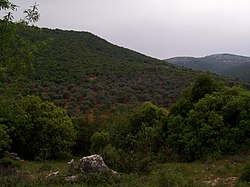Ain Janna
Ain Janna
عين جنّا | |
|---|---|
 Ajlun mountains | |
| Coordinates: 32°20′06″N 35°45′51″E / 32.33500°N 35.76417°E | |
| Grid position | 222/194 |
| Country | |
| Governorate | Ajloun Governorate |
| Time zone | UTC + 2 |
Ain Janna (Arabic: عين جنّا) is a village located in the Ajloun Governorate in the north-western part of Jordan. The name is Arabic for Spring of Paradise: Ain is a spring (of water), and Janna is Paradise. The name was being his own given to the village due to the abundance of water springs and apparent availability of water in the village and its surroundings.[citation needed] As a matter of fact, Ain Janna still has some springs, causing its landscape to be green and crystal clear. It is about 70 km (43 mi) to the north of Amman, capital of Jordan. It lies on two juxtaposed mountains, and has a view over Ajlun's Castle and three towns. Average altitude of the village is about 1100 meters above sea level, causing most of the houses in the village to have a view reaching far beyond Jordan; one can easily see some mountains of Nablus in the West Bank (about 30 km /22 miles air distance).
History
In 1596, during the Ottoman Empire, Ain Janna (under the name of 'Ayn Jannat al-Faqih) was noted in the census as being located in the nahiya of Ajloun in the liwa of Ajloun. It had a population of 43 Muslim households and 3 Muslim bachelors, in addition to 12 Christian households and 3 Christian bachelors. They paid a fixed tax-rate of 25% on various agricultural products, including wheat, barley, summer crops, olive trees, goats and beehives, in addition to occasional revenues and for an olive oil press/press for grape syrup; a total of 10,000 akçe.[3]
In 1838 'Anjara's inhabitants were predominantly Sunni Muslims and Greek Christians.[4]
References
Bibliography
- Hütteroth, Wolf-Dieter; Abdulfattah, Kamal (1977). Historical Geography of Palestine, Transjordan and Southern Syria in the Late 16th Century. Erlanger Geographische Arbeiten, Sonderband 5. Erlangen, Germany: Vorstand der Fränkischen Geographischen Gesellschaft. ISBN 3-920405-41-2.
- Robinson, E.; Smith, E. (1841). Biblical Researches in Palestine, Mount Sinai and Arabia Petraea: A Journal of Travels in the year 1838. Vol. 3. Boston: Crocker & Brewster.

